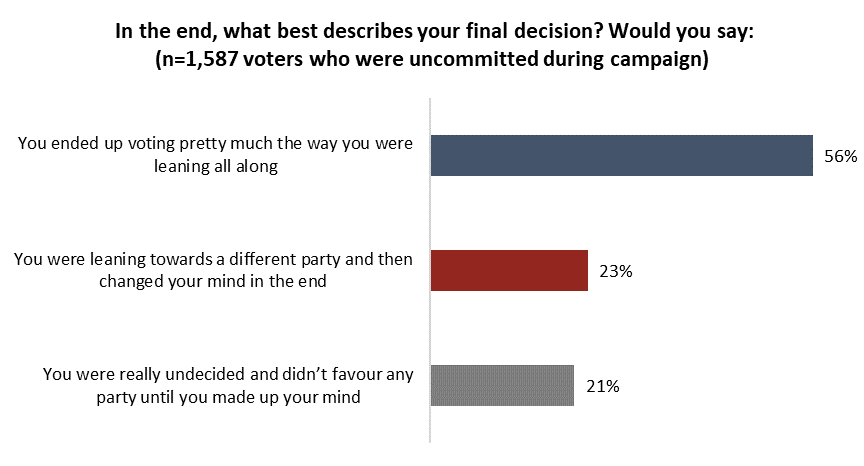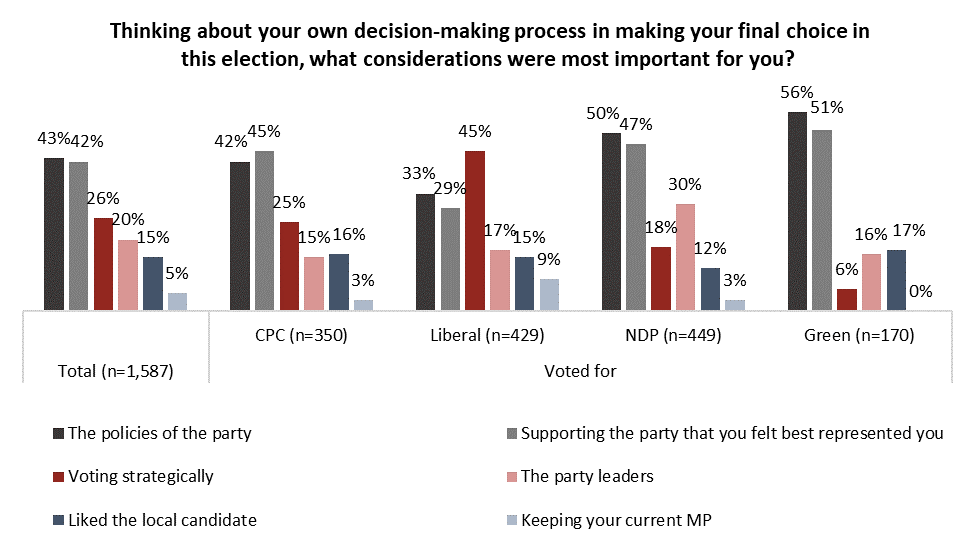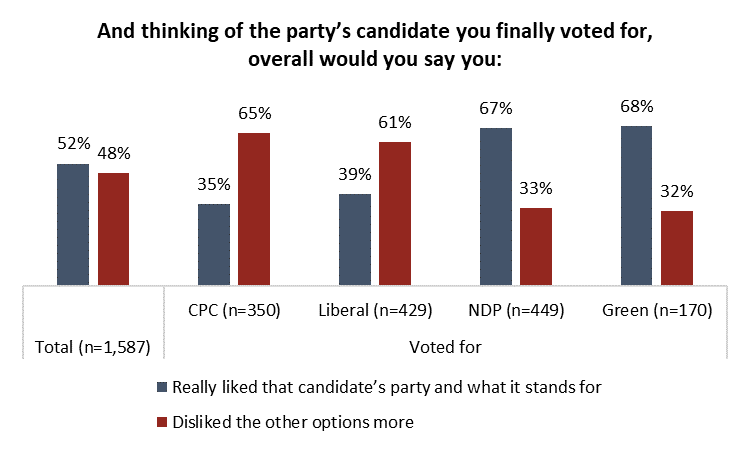Why and when did uncommitted voters lock in? Study shows Liberals benefitted most from strategic voting

Study canvassed Canadians who were uncommitted during campaign about decision-making process
October 25, 2019 – In the hours of ballot counting, as political commentators filled airtime and candidates nervously chewed their nails, a narrative of how one of the closest elections in Canadian history came to be emerged: strategic voting.
Though the struggling Liberals may not have captured the most votes, nor secured enough seats in the House of Commons for a majority, new data confirms they were able to successfully persuade enough voters to help their cause, even begrudgingly, rather than support another party which may have helped to elect the Conservatives.
A post-election survey from the non-profit Angus Reid Institute re-canvassed voters who were still considering their options, even into the late innings of the campaign. Their responses reveal that among those who voted strategically, most chose the party of Prime Minister Justin Trudeau.
The study also offers a glimpse of just how volatile the campaign was. Nearly one-quarter of late deciding voters (23%) say although they were leaning towards one party, they changed their minds and cast a ballot for another in the end.
More Key Findings:
- More than one-fifth (23%) of late deciding voters say they left their decision for the final day, while another 12 per cent say they settled on their candidate in the last couple of days
- Green Party and NDP voters are most likely to say that their vote was primarily based on the policies that the party put forth during the campaign, and the idea that they felt those parties best represented them
- Ultimately, half of late deciding voters (52%) said that they supported a candidate because they liked what they and their party offered, while half (48%) said that they simply disliked the alternatives more
About ARI
The Angus Reid Institute (ARI) was founded in October 2014 by pollster and sociologist, Dr. Angus Reid. ARI is a national, not-for-profit, non-partisan public opinion research foundation established to advance education by commissioning, conducting and disseminating to the public accessible and impartial statistical data, research and policy analysis on economics, political science, philanthropy, public administration, domestic and international affairs and other socio-economic issues of importance to Canada and its world.
INDEX:
-
The soft voters
-
How long did they wait to decide?
-
How much switching occurred?
-
Close to half of ‘later Liberals’ voted strategically
-
Half voted for a party, half against one
The soft voters
Throughout the election campaign, the Angus Reid Institute asked potential voters to reflect on the certainty of their vote. There were four options that a respondent could choose to describe their current vote intention:
- Absolutely certain of who you will support – No way you could change your mind
- Fairly certain – You feel like you’ve made up your mind
- Less certain – You could change your mind
- Not certain at all – You have no idea who you’ll support
As we noted, even late in the campaign, half of voters had not yet made up their minds, falling into one of the latter three categories based on that question. In order to generate a window into these voters’ motivations and decisions, ARI researchers went back to these late-deciding voters with a follow-up survey.
Once the polls had closed, respondents who had answered that they were less than absolutely certain during the final three weeks of the campaign received a survey asking them a number of questions about which party they supported, why and when they made their decision. Note that this survey is not designed to simulate the election outcome with complete accuracy, but to understand the personal calculations at play among these less-than-certain voters in the final days and weeks of the campaign.
How long did they wait to decide?
The federal election increasingly appeared as though it would be close in the final days of polling, and ultimately, it was. The Conservative Party edged out the Liberals in the overall vote, 34 per cent to 33 per cent, while the Liberals won more seats, forming a minority government.
Among the nearly 1,600 voters canvassed in this survey, only two-in-five (38%) say they had made their mind up by the middle of the campaign. The rest were still weighing their options in the waning days. In fact, one-quarter of late deciding voters say they made their mind up on voting day:

How much switching occurred?
Just over half (56%) of late deciding voters say that they stayed with their first choice for the entire campaign with little wavering, even though they were unable to say during that time that they were “locked in”. For two-in-five (44%) their decision was far less settled.
Overall, one-quarter of late deciding voters say they ultimately changed their mind from their first choice at some point in the campaign:

NDP supporters were the least likely to have decided early on that they would vote for that party. Indeed, only half (48%) say they were leaning that way all along. Three-in-ten who supported the party say they were initially intending on supporting another.
Conservative and Liberal voters are almost identical to each other in terms of their decision making, with two-thirds leaning toward that party the whole time, and one-third either undecided or having switched from their first choice:

Close to half of ‘later Liberals’ voted strategically
One of the political undercurrents of the campaign was the potential for strategic voting. A considerable number of ridings across the country were expected to be extremely close, which, it was suggested, could lead to vote switching as voters tried to block a party rather than support their first choice. When asked for their primary motivation for their vote, one-quarter said that the strategic element of blocking a party they disliked was a part of their decision. This was, however, a consideration for far more Liberals (45%) than any other group of party supporters.
Those who ultimately settled on the NDP and Green Party were most likely to say that the policies of those parties and the personal representation they felt they would get were their top reasons.

Looking at this another way, half of late deciding voters say that they voted for their party’s candidate because they really liked the party and what it stands for, whereas the other half say that they simply disliked the other options more. Conservatives and Liberals were considerably more likely to say that they were simply less enamoured with other choices, rather than enthusiastic about their own:

For detailed results by age, gender, region, education, and other demographics, click here.
To read the full report, including detailed tables and methodology, click here.
Click here to read the full questionnaire used in this report.
MEDIA CONTACTS:
Shachi Kurl, Executive Director: 604.908.1693 shachi.kurl@angusreid.org @shachikurl
Dave Korzinski, Research Director: 250.899.0821 dave.korzinski@angusreid.org

